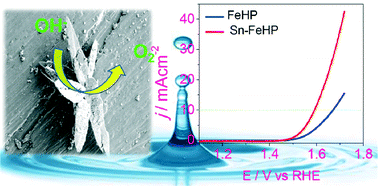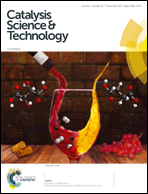Iron hydroxyphosphate and Sn-incorporated iron hydroxyphosphate: efficient and stable electrocatalysts for oxygen evolution reaction†
Abstract
A new class of metal hydroxyphosphates, to be used as an alternative to noble metal catalysts for better oxygen evolution reaction (OER), has been identified and in particular iron hydroxyphosphate (Fe5(PO4)4(OH)3·2H2O, FeHP) has been used because of its performance in electrocatalytic water oxidation in an alkaline medium. To assist the coordination of –OH− ligands with the metal center and also to weaken the M3+–OH bonding, which is desirable to enhance the OER behavior, tin (Sn) has been incorporated to form Sn entrapped iron hydroxyphosphate, otherwise known as Sn incorporated FeHP (Sn-FeHP) which is another new electrocatalyst, which has been identified and characterised in the current study. Symmetrical nanocrystals of FeHP and Sn-FeHP were prepared using a simple hydrothermal method with appropriate metal precursors at 220 °C for 48 h. Interestingly, the incorporated Sn does not lead to any change in the orthorhombic crystal structure of pristine FeHP. However, the effect of the added Sn is found to be reflected in the morphology by way of forming self-assembled needle-like crystals to ultimately form a star-like architecture. The ability of these nanocrystals to perform in electrocatalytic water oxidation in alkaline conditions as anode for the OER was studied in comparison with the state-of-art ruthenium(IV) oxide (RuO2) and with the best performing alkaline OER catalyst from 3d VIII group metals, i.e., nickel(II) hydroxide [Ni(OH)2]. The results of the OER study suggest that the currently synthesized Sn-FeHP possesses better catalytic ability than that of pristine FeHP. The overpotential (η) required to achieve the benchmarking current density of 10 mA cm−2 is 359 mV for Sn-FeHP and 442 mV for FeHP. Similarly, the Tafel slope of Sn-FeHP and FeHP is 81 and 91 mV dec−1, respectively, suggesting that the Sn-FeHP explored in this research is a better electrocatalyst for OER. The enhanced activity of Sn-FeHP compared to that of Fe-HP may be correlated to the morphology-based advantages and the effect of added Sn in altering the electronic structure of FeHP, which in turn favors the OER kinetics. The stability of the Sn-FeHP modified working electrode was supported by the constant i–t performance for more than 800 min at 1.65 V versus a reversible hydrogen electrode (RHE). Thus, Sn-FeHP could be considered as an efficient, cheaper and alternative futuristic anode material in comparison to the expensive nickel-based electrocatalysts, exploited commonly in water electrolysers.



 Please wait while we load your content...
Please wait while we load your content...